Ladakh - Land of Moons
If one wishes to experience totally different adventure sports, visit the majestic monasteries and celebrate the Buddhist festivals, no other place can compete with the "little Tibet"- Ladakh. Set amidst two of the world's most powerful mountain ranges, the Karakoram and the Great Himalayas, Ladakh is a nirvana for adventure lovers. Offering sports like mountain climbing, cycling, jeep safari tours, yak safaris, mountaineering, and trekking, Ladakh makes your holidays memorable for a lifetime. It is a holy Buddhist pilgrimage comprising of several monasteries and gompas, that depict a typical Buddhist art and architecture.
PLACES IN LADAKH
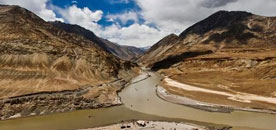
Indus Valley :
At an average elevation of 3500 m is sand-witched between the Zanskar Range on its South and the Ladakh Range on its North, This is the geographical backbone, and the historical heartland of Ladakh. All major sites connected with its dynastic history are here, starting with Leh, the capital city. The bulk of the population resides along the Indus. Its main attraction are the numerous Buddhist monasteries, quaint villages, fairs , festivals and bazars. Air and road communications converage at Leh. 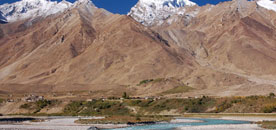
Zanskar Valley :
The Valley of Zanskar is situated in the inner Himalaya and is higher than most areas of Ladakh. The climate is very Harsh and receives very little rain fall. The twin peaks of Nun-Kun, its Monasteries and its extremely rugged, awe-aspiring landscape are its main attractions. The Zanskar Range is a mountain range in the Indian state of Jammu and Kashmir that separates Zanskar from Ladakh. Geologically, the Zanskar Range is part of the Tethys Himalaya, an approximately 100-km-wide synclinorium formed by strongly folded and imbricated, weakly metamorphosed sedimentary series. The average height of the Zanskar Range is about 6,000 m (19,700 ft).
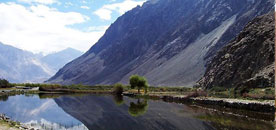
Nubra Valley
Nubra Valley is about 150 km north of Ladakh. Local scholars say that its original name was Ldumra (the valley of flowers). The Shyok River meets the Nubra or Siachan River to form a large valley that separates the Ladakh and the Karakoram Ranges. The average altitude of the valley is about 10,000 ft. above the sea level. The common way to access this valley is to travel over the Khardung Lafrom Leh. Non-locals require an "Inner Line" permit (easily obtained in Leh town) to enter Nubra. 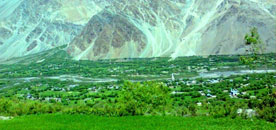
Sankoo Valley :
A picturesque expanse surrounded by colorful rocky mountains, Sankoo is an upcoming township with a small bazaar (42 kms south of Kargil) and numerous villages around. Dense plantations of poplars, willows, myricarea and wild roses fill the bowl shaped valley, giving it the ambience of a man-made forest tucked within the mountain ramparts. Two side valleys drained by large tributary streams of the Suru river, the Kartse flowing from the east and the Nakpochu descending from the west, open up on either side of the expanse.
PILGRIMAGES IN LADAKH
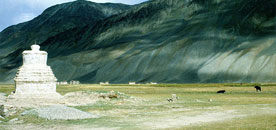
Padum :
Padum, situated at a height of 3505 meters, serves as the administrative headquarters of the Ladakh region. Once the capital of the ancient kingdom of Zanskar, it now houses a population of nearly 1500. Muslims constitute nearly half of the population of the town. A huge boulder near the river bank with ancient rock carving, dating back to the 8th century, is a living proof of the fact that North Indian Buddhism has had influence in this region since ancient times.
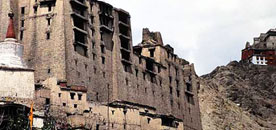
Zangla :
Zangla is situated to the north of Zanskar and was ruled by a titular king till a few years back. There is an old hilltop castle mostly in ruins, a small chapel, an old Nunnery, etc worth visiting in Zangla. The village of Tsa-zar, mid-way between Stongdey and Zangla, houses an old monastery with some beautiful frescos. Zangla also serves as the focal point on the Padum-Strongdey-Zangla-Karsha-Padum round trip, covering most of the cultural sites of Zanskar. 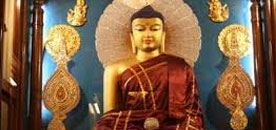
Buddhist Pilgrimage :
There are numerous Buddhist monasteries in Ladakh that serve as one of the major tourist draws. The famous monasteries of Phyang, Hemis and Chemrey belong to the Namgyal dynasty period. Then, there are the monasteries of Thikse, Likkir, Rhidzong and Spituk in central Ladakh, which belong to the reformist group. Almost every monastery in Ladakh serves as a venue for one festival or the other. Even meditation sessions are held in Ladakh in summers at the Mahabodhi Meditation Center on Changspa Lane. MONASTERIES IN LADAKH

Alchi Gompa :
The Alchi Gompa is situated on the banks of the Indus and was founded thousand years back. On one of the walls of the monastery are thousands of miniature-sized Buddha pictures. 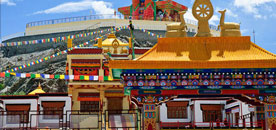
Diskit & Hundur Gompa :
The Diskit & Hundur Gompas of Ladakh are situated in the Nubra Valley of the Ladakh region. Built by Changzem Tserab Zangpo, a disciple of Tsong-kha-pa, the Diskit Gompa dates back to the 14th century. 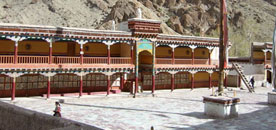
Hemis Monastery :
The Hemis Monastery at Ladakh is situated at a distance of approximately 47 km from Leh, on the west bank of the Indus River. The monastery stands concealed inside a gorge and belongs to the Dugpa Order.
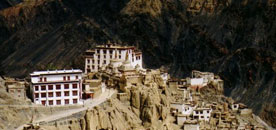
Lamayuru Monastery :
The Lamayuru Monastery of Ladakh is situated at a distance of approximately 127 km to the west of Leh. The legend associated with this monastery goes that at the time of Sakyamuni (the Historical Buddha), nags (holy serpents) used to live in a Lake at the present day Lamayuru's valley. 